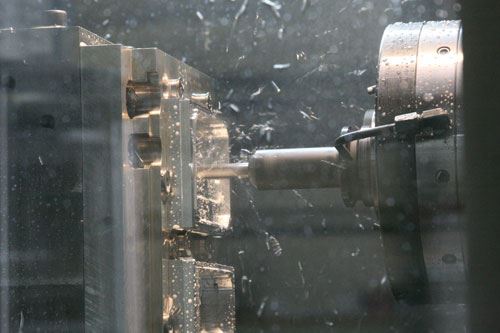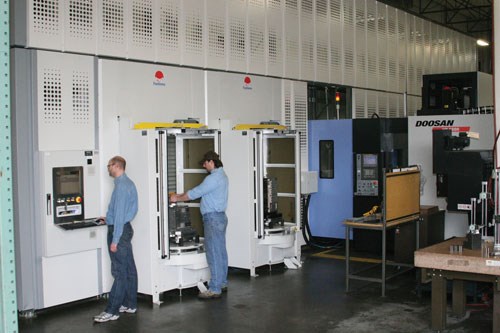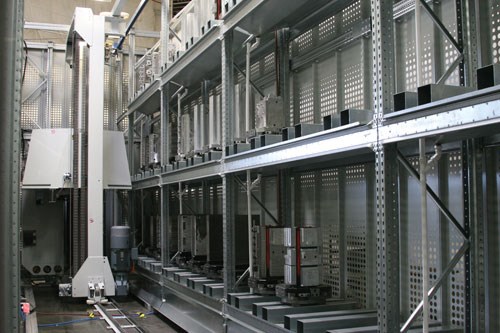Cell Works the Night Shift
At this aerospace and medical component manufacturer, a Doosan HMC paired with a flexible pallet magazine and cell controller from Fastems has increased production and part quality while eliminating variation throughout the production chain.
Share





Every night at 12:30 a.m., the shift manager at Westwood Precision flips off the optional stop toggle on the Doosan cell, makes sure everyone’s gone, turns out the lights and locks the doors. John Landau, production manager at the Everett, Washington-based contract shop, admits it was a bit unsettling at first to leave the Doosan HMC and integrated Fastems pallet magazine running unattended all night. A year and a half after installation, however, he says he’s “amazed” at what the system has done for machine utilization, which is now close to 94 percent on a 24-hour clock. In addition to improving productivity, running unattended nearly 24/7 has reduced the time, cost and stress associated with setups while eliminating variation throughout the production chain.
The 35-person shop specializes in close-tolerance machining of complex aerospace and medical components in small to medium lot sizes. Gordon Nisbet, company president, attributes the company’s success since its 1982 founding to its commitment to continuous improvement. The decision to purchase the cell—the company’s single most expensive capital investment—last summer in the midst of the recent recession is a testament to that commitment, Mr. Nisbet says. “Economic conditions posed a threat, but the slowdown also gave us the time we needed to adapt our company to make it more competitive, more productive, more efficient, more predictable and just all-around better,” he recalls.
The company determined that the next step toward meeting those goals was automation. Like those in many other shops, Westwood operators had a long list of steps to check off before hitting the cycle start on any given job. Tearing down the previous setup; switching out the fixtures and subplate; loading and unloading tools; uploading the next program; touching off the first tool; and other, smaller steps in between consumed significant amounts of production time. Downtime and associated costs were even greater when accounting for shift changes, breaks and the fact that shutting machines down every night essentially amounted to an entire shift of lost production.
Work lots, types and sizes all dictated certain basic machine tool and work storage specifications for any new equipment. The targeted work consisted of close-tolerance, prismatic aluminum parts requiring simultaneous X-, Y- and Z-axis movements with anywhere between 20 and 100 tools. Lot sizes ranged from 1 part to 250 or more, but typically between 25 and 100. Typical tolerances were measured in tenths, and surface finish requirements were stringent. Due to the unpredictable nature of its aerospace work, the shop also wanted to be able to set up 30 or more jobs in advance and run any one at a moment’s notice.
Evaluating these and other requirements led the shop to conclude that it would require a rigid HMC capable of repeating within tenths at heavy cutting depths and high feeds and speeds. That machine would be outfitted with an automated, computer-controlled pallet system. That system would have to be expandable—that is, the shop would need the ability to add to the pallet pool when necessary and incorporate new control functionality when available. After careful consideration, the company settled on an HP 4000 HMC from Doosan Infracore (West Caldwell, New Jersey) and an FPM750 Flexible Pallet Magazine (FPM) and cell controller from Fastems (West Chester, Ohio).
With a 14,000-rpm spindle, a top feed rate of 1,181 ipm and rapid traverse of 2,362 ipm, the four-axis HMC’s mechanical attributes fit the bill for the shop’s job requirements. On the control side, its Fanuc 31i CNC with AICC Nano Type II high speed software provides 200-block advance position calculation to maintain these high speeds and feeds during simultaneous multi-axis movements. Additionally, the machine’s 30-hp spindle enables it to handle the required roughing chip loads, while its 262-tool ATC has sufficient capacity to minimize tool changes between jobs.
The machine was integrated with the three-level, 48-pallet FPM via the combined efforts of engineers from Fastems, Doosan and CNC Machine Service, the local Doosan distributor. The FPM includes a setup station for loading parts and a stacker crane to transport pallets to and from the container. The cell controller offers tool monitoring capability and stores job packs containing setup sheets, blueprints and other turnkey data for use by employees with password permission.
Setup technician Jason Vise was busy prepping jobs for the system long before it arrived. All were aluminum parts because material inconsistencies in ferrous metals could cause problems during lights-out operation, he says. Chosen jobs also consisted of repeat parts with unpredictable schedules. Preparing these parts in advance would enable their quick completion without jeopardizing other work.
The new cell’s benefits became apparent shortly after production began. Mr. Vise says one significant time-saver is the cell controller’s ability to prioritize job scheduling based on key variables, including required delivery, programmed tool life and tool availability. “All of this scheduling is going on in the controller, automatically, based on our entering key variables for each job.”
The flexibility that comes with automatic rescheduling based on a complicated set of conditions has reduced inventory and improved cash flow, Mr. Landau says. He cites one example in which the control recommended skipping the next job in favor of two different, more urgent jobs. “Based on three job sizes, cycle times and delivery requirements, it determined that we could complete and ship two smaller jobs and still have enough time to run the originally scheduled job without any delay in the required delivery.”
The Doosan HMC offers its own benefits. Mr. Landau says the machine’s rigidity facilitates heavier cuts at faster speeds and higher feeds. He recalls one particular job involving close-tolerance housing components that the shop moved from a different machine to the new HMC shortly after it was installed. With the feed-rate override set at 150 percent, the new machine completed each part in 3 minutes and 45 seconds—50 percent less time than the previous machine. Additionally, the ability to run the parts at the higher feeds and speeds recommended for that particular combination of tool and material improved surface finish quality by nearly 50 percent. Overall cleaner cutting eliminated most of the hand deburring, reducing total cycle time for that secondary operation from more than seven minutes to less than one minute per part.
With the previous machine, the shop had to reduce the feed rate to meet tolerances on parts mounted at the top of the tombstone fixture or farthest away from the pallet table. “The cutter was working far enough out from the bearing surface to act like a long lever,” Mr. Landau explains. “We had been getting too much deflection between the pallet table and the coupling. On the Doosan, running at a 50-percent faster feed rate, there was still no deflection.”
These gains were particularly notable because the part’s surface included a 3D radius that blends into a straight wall, he says. This required simultaneous X-, Y- and Z-axis movement. Much of the cycle time savings were achieved during these moves, which involved toolpath calculations that many CNCs couldn’t handle. In that scenario, he says, the CNC typically suppresses the programmed feed rate. That was a non-issue for the Fanuc CNC and its 200-block look-ahead capability.
In addition to improving productivity and part quality, the cell has redefined the company’s notion of what setups should entail, Mr. Vise says. Running virtually 24/7 has reduced interruptions and downtime previously associated with change-overs. Mr. Landau adds that production control is easier and more effectively executed. “We’ve eliminated variation at many points in the production chain. We don’t see the spikes in production like we used to. We see higher, straighter-line charts, and that’s a very good thing.”
Related Content
Orthopedic Event Discusses Manufacturing Strategies
At the seminar, representatives from multiple companies discussed strategies for making orthopedic devices accurately and efficiently.
Read More5 Tips for Running a Profitable Aerospace Shop
Aerospace machining is a demanding and competitive sector of manufacturing, but this shop demonstrates five ways to find aerospace success.
Read More4 Commonly Misapplied CNC Features
Misapplication of these important CNC features will result in wasted time, wasted or duplicated effort and/or wasted material.
Read MoreAdditive/Subtractive Hybrid CNC Machine Tools Continue to Make Gains (Includes Video)
The hybrid machine tool is an idea that continues to advance. Two important developments of recent years expand the possibilities for this platform.
Read MoreRead Next
Building Out a Foundation for Student Machinists
Autodesk and Haas have teamed up to produce an introductory course for students that covers the basics of CAD, CAM and CNC while providing them with a portfolio part.
Read More5 Rules of Thumb for Buying CNC Machine Tools
Use these tips to carefully plan your machine tool purchases and to avoid regretting your decision later.
Read MoreSetting Up the Building Blocks for a Digital Factory
Woodward Inc. spent over a year developing an API to connect machines to its digital factory. Caron Engineering’s MiConnect has cut most of this process while also granting the shop greater access to machine information.
Read More






























.jpg;maxWidth=300;quality=90)








